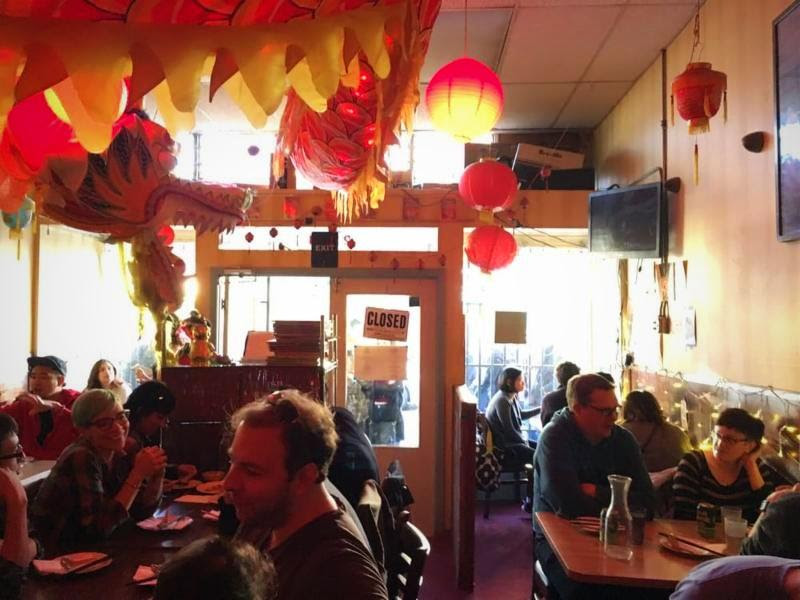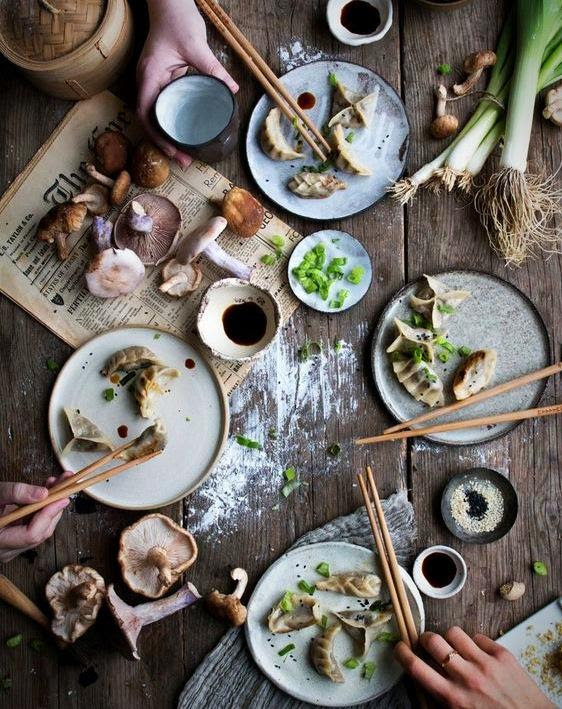My sister and I are sitting on opposite sides of the table in a drafty Vietnamese restaurant, slurping up bowls of Pho, on the afternoon before New Year’s Eve. We are each consulting our disintegrating copies of The Key To Chinese Cooking, authored by Irene Kuo. In the midst of planning what we are calling “a Chinese feast”–but which Kuo titles a “meal without ceremony,” or an “abbreviated banquet”–Joy and I intend to make eleven different elements to compose a five-course meal. It certainly seems “with ceremony” to us.
Both she and I are buoyant at the prospect of serving this “meal” to my husband and her fiancé–as excited as we are also to revisit the past. We had discovered Szechuan cuisine together back when Joy found Shanghai Garden, an inexpensive and diminutive restaurant, where for the first time I tasted the fire of Kung Pao chicken and crisp and garlicky Yu-shiang broccoli.
Having grown up on “American” home-style cooking, the flavors themselves amazed us, and the vegetables were worlds different than the mushy, frozen ones served at my grandmother’s table. Joy and I had often cooked other dishes in her tiny apartment on the backside of Beacon Hill. We bonded over her robust chili and homemade tortillas, and she came to my place for refined French. Our first cooking experience together, it was not to be our last. We began to phone each other most days, and got together on weekends.

I had first learned to cook as a teenager, when my father taught me his personal recipes, and in the ensuing years, I had mastered all of Julia Child’s series The Art of French Cooking. But I was tired of consommé and chocolate soufflé and béarnaise sauce; looking for a new challenge, I found a small Chinese grocery store. Anxiety poured through me as I searched through unfamiliar and precarious stacks for ingredients whose names I couldn’t pronounce. The proprietor peered over his glasses at me with curiosity, as if I were some odd species. Nevertheless, I took home two bags that brimmed with the many spices and sauces that would go into creating the cuisine of a country I had never even visited.

At the bookstore, I had picked out a cookbook filled with enticing and glossy photos–but my first experiment was an embarrassing failure. The recipe used ten Szechwan peppers and two tablespoons of garlic chili paste for Kung Pao. After the first step of sautéing the chilies in oil, the fumes grew so pungent that, with eyes blurred by tears and non-stop coughing, my husband and I and our dinner guests left the apartment. Pizza replaced Chinese that night. My dream was as far away as the abandoned skillet I faced when we returned home.
But Joy and I continued to crave this spicy food. Back at the bookstore, I scoured the shelves for the sort of book I’d studied from Julia Child’s series–one that explained what you were doing and why. No photos, just technique. When I pulled Irene Kuo’s from the shelf, which advised only two or three Szechuan peppers, and a mere teaspoon and a half of garlic chili paste for the dish I had botched, I knew I’d found it.
I went on to learn nearly every recipe from that book, reveling in cooking much of what Joy and I ate when we asked the owner of Shanghai Garden to bring us whatever was best on a particular night. For Christmas that year, I bought her her own copy of the book, in which I transcribed my handwritten notes. Soon it was as stained as mine.
Even now, as we spoon up our Pho this afternoon, creating a feast to offer to our special guys–because, after all, food does equal love–we return to cooking together again with familiarity and friendship. We choose an appetizer course with a platter of scallion oil shrimp, spicy minced watercress, and chilled sweet and sour red onions. Then Kung Pao beef. Then hot and soup crammed with ingredients that would put a restaurant to shame. Then a red-cooked ham simmered all day in dark soy, sherry, stock, and the critical spices of cinnamon and star anise. Then room temperature stir-fried zucchini with shredded carrots. The meal is rounded out by chicken fried rice. We follow each rule of presentation and the order Kuo lists for simple banquets, but cut out both the fish and chicken courses.
Our men receive this gift of the meal with high praise. Joy and I smile at each other across plates scraped bare. As everyone begins to clear the dishes, she and I give one another a hug, a tight one, and when the family grandfather clock chimes twelve times, the four of us doff flutes of champagne. Joy and I wave goodbye to 2017 with the sort of companionship founded upon our past, and welcome in 2018 eager for our future. How apt is Philip Larkin’s voice in a line of his oft-quoted poem: “what survives of us is love.” In my life, this has certainly been so.

Yours,
Linda
Have a comment or feedback? Talk to Linda!

